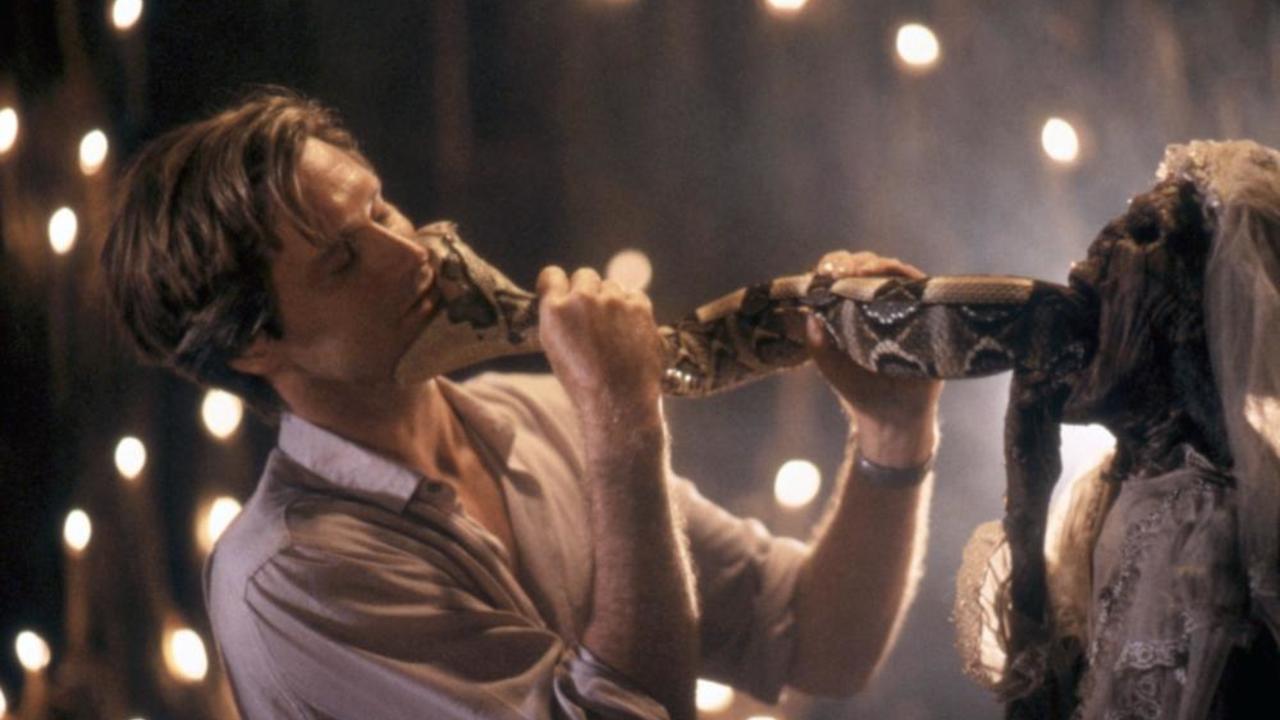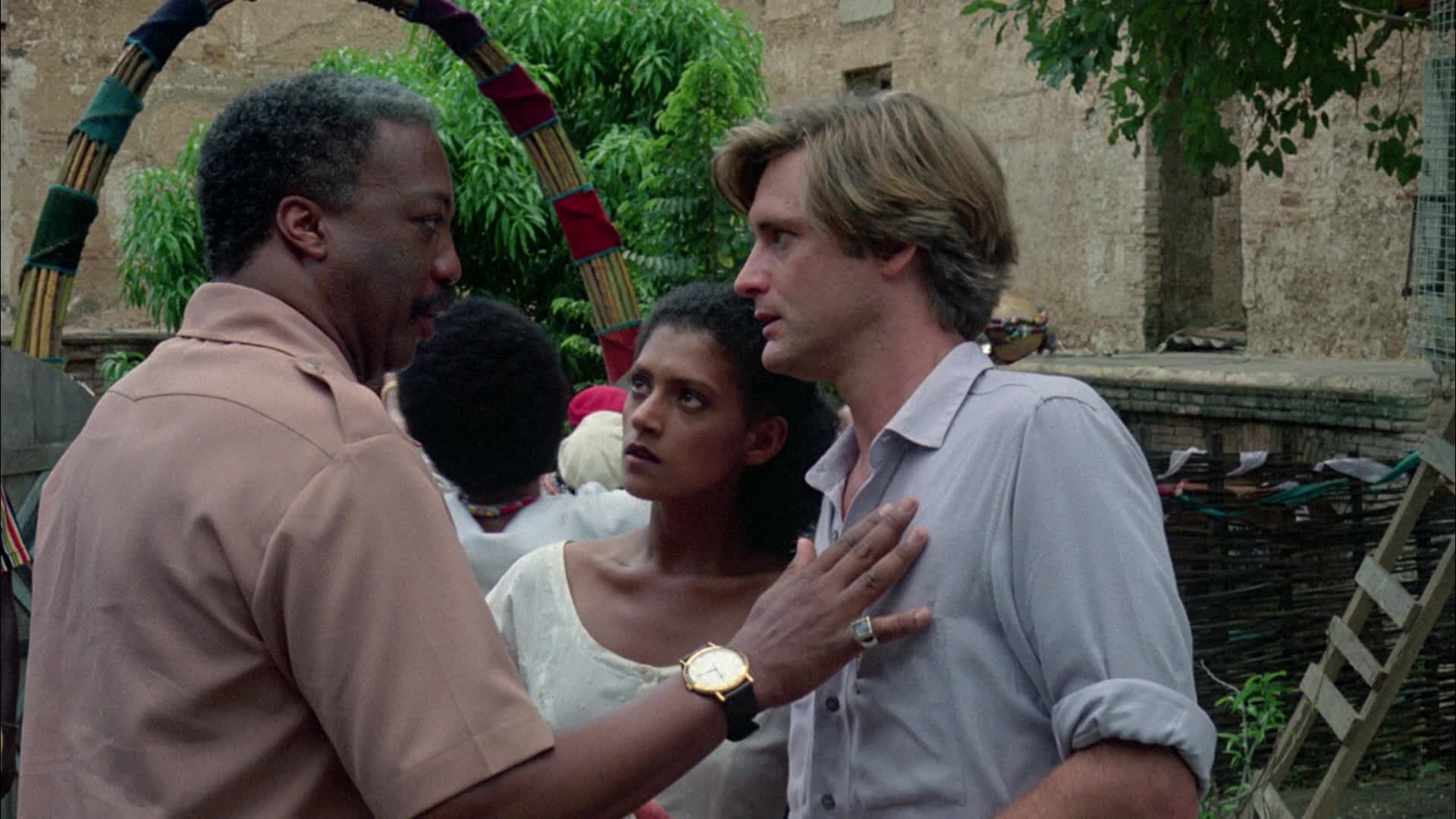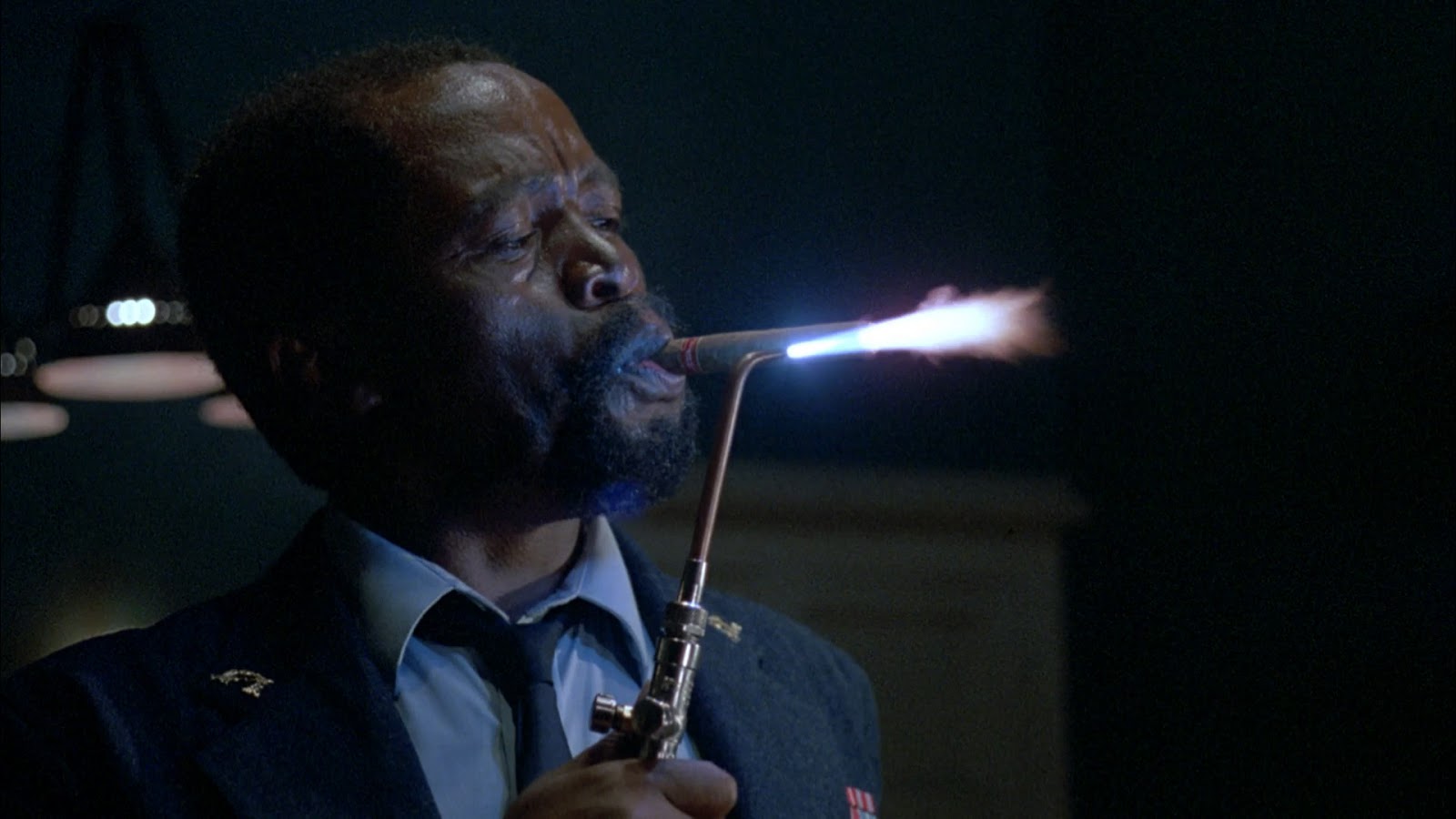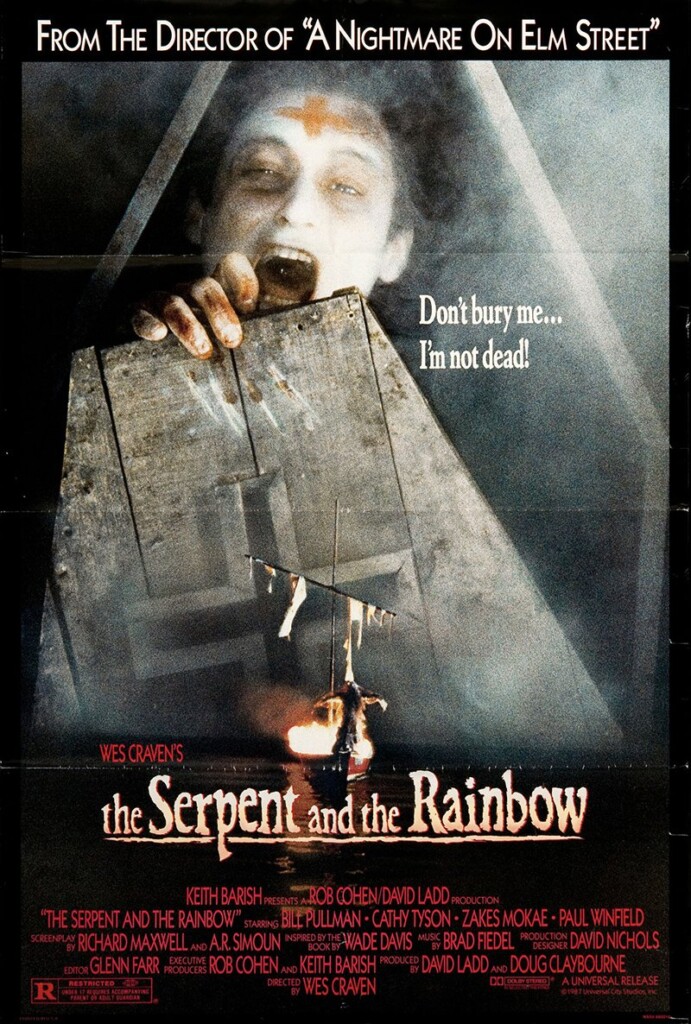USA. 1988.
Crew
Director – Wes Craven, Screenplay – Richard Maxwell & A.R. Simoun, Based on the Book The Serpent and the Rainbow: A Harvard Scientist’s Astonishing Journey into the Secret Societies of Haitian Voodoo, Zombies and Magic by Wade Davis, Producers – Doug Claybourne & David Ladd, Photography – John Lindley, Music – Brad Fiedel, Visual Effects Supervisor – Gary Gutierrez, Makeup Effects – David & Lance Anderson, Production Design – David Nichols. Production Company – Serpent and Rainbow Productions.
Cast
Bill Pullman (Dennis Alan), Cathy Tyson (Marielle Duschamps), Zakes Mokae (Dargent Peytraud), Brent Jennings (Luis ‘Mozart’ Muldaur), Paul Winfield (Lucien Celine), Conrad Roberts (Christophe Duran), Michael Gough (Eric Steinbauer)
Plot
Harvard anthropologist Dennis Alan is hired by a pharmaceuticals company to go to Haiti and find the drug used in voodoo rituals to create zombies. With the aid of a Haitian psychologist, Alan searches for the elusive proof of an actual zombie and the drug. His quest takes him deep inside the Haitian voodoo religion where he encounters many disturbing things. However, he also attracts the attention of Dargent Peytraud, the Haitian Minister of Secret Police and a practicing houngan, who brutally tortures Alan and then has him buried alive.
The story behind The Serpent and the Rainbow is an utterly fascinating one. The film was based on a 1985 non-fiction book by Canadian-born Wade Davis. Davis holds a PhD from Harvard in the rare field of ethnobotanity – the science of examining the anthropological significance of ritual and cultural drugs and evaluating the medicinal use of traditional natural remedies. In 1982, Davis went on an expedition to Haiti and eventually tracked down and analysed the drug that was used in traditional zombiefication rituals.
The pharmacological analysis makes for interesting reading in the book but what is even more fascinating is Wade Davis’s determination to examine the cultural embedding that voodoo beliefs come in. Davis extensively charted the origins of voodoo religion in Western Africa and its merging with Roman Catholicism during the French colonial occupation of Haiti.
Moreover, Davis delved deeply into the so-called secret societies – largely rural communities that are socially dominated by voodoo beliefs. Zombiefication is usually meted out as a punishment for those who have transgressed the social code of these secret societies. Most fascinating is Wade Davis’s eventual conclusion that zombiefication involves the use of a drug that produces catatonia but where the notion that the recipient has died is created out of the beliefs of the culture surrounding the victim.

The book passed through several hands as a film property and eventually ended up in those of Wes Craven. Craven’s name was certainly at the forefront of horror directors of the day. Craven first established a name for himself in the 1970s with shock and brutality classics like The Last House on the Left (1972) and The Hills Have Eyes (1977). After several uncertain moves towards the mainstream, Craven then had an enormous hit with A Nightmare on Elm Street (1984). It was after Elm Street that Craven became increasingly regarded as a major new name in horror.
Though his output throughout the 1980s was sometimes uneven, Wes Craven emerged as a strong intellectual director whose material constantly circles through a fascination with dream, reality and meta-fictions, with the fascinating likes of this, The People Under the Stairs (1991) and Wes Craven’s New Nightmare (1994). Of course, the work in recent years that endeared Wes Craven to a new generation proved to be the slasher parody/deconstruction Scream (1996) and sequels. While most prefer A Nightmare on Elm Street or Scream, or even go all the way back to The Last House on the Left and The Hills Have Eyes as Wes Craven’s best works, in my (minority) opinion the muchly underrated The Serpent and the Rainbow represents the finest hour-and-a-half we have had yet from Wes Craven.
Not a lot in The Serpent and the Rainbow always makes sense but then Wes Craven films often operate on a dream logic of surprise shocks more so than they ever do rational linear explanations. Craven lets loose with an astounding procession of surreal and horrific images – bridal gown-garbed zombies; jaguar spirits; drownings in coffins of blood; possessions; a replay of The Godfather (1972) scene with Bill Pullman waking up next to a decapitated human head; an opening scene where a needle is poked inside a corpse’s eyeball to see if it is still alive; and chases through corridors filled with clawing, metre-long arms.

One of the most outlandish scenes takes place at a respectable dinner party where Bill Pullman keeps hallucinating a mummified hand popping up out of the soup tureen, before the hostess suddenly bites into her wine-glass and jumps across the table and tries to slash him with it. The image of Bill Pullman buried alive, unable to move as the spider that Zakes Mokae throws in the coffin as a parting gift crawls across his eyeball, lit only by a crack of light coming from the crucifix cut into the wood of the coffin lid, has a chillingly elegant classicism of horror about it – it is the type of image that might have come in a Val Lewton film of the 1940s.
Of course, the film version varies considerably from what happened to Wade Davis in real life. The film freely elaborates on the book with a strong emphasis toward horror – Davis, for instance, was not arrested by the secret police or buried alive. In fact, Wade Davis was not happy with the film version and accused it of buying into the very Western myths about voodoo that he was seeking to disseminate in the book.
On the other hand, Wes Craven does not neglect Wade Davis’s portrait of Haitian culture. While the film is filled with remarkable pop-up images of horror, it is also one where the horror vies with moments of great beauty – the procession of a painted float of the Virgin Mary up a mountainside and a love scene in an aquamarine-lit holy grotto.
Some parts of the film do not entirely work. The voiceover narration is unnecessary, the climax with the burned Peytraud returning to life is overextended, and the Amazon Basin opening scenes do not work – the segue into dream at the start of the film is too abrupt. Bill Pullman’s cocky pig-headed performance is an irritation but Cathy Tyson has a serious intensity, which makes her moments of unrestrained passion even more striking.

However, the film is dominated by an evil and singularly frightening performance from Zakes Mokae. (Though the equivalent of such a character was not in Wade Davis’s book, Peytraud is based on Francois ‘Papa Doc’ Duvalier, the dictator of Haiti between 1957 and 1971, who headed the tonton macoute, the Haitian secret police, and regularly tortured members of the populace and advertised the fact that he was a practicing voodoo houngan). Wes Craven has cast the part as though to play on all the White man’s fears of the Black man and Zakes Mokae’s sweating, skull-like ebony face and low, hissing intonation confirms it. The scene where Mokae hammers an iron spike into Bill Pullman’s crotch is almost unbearable in impact.
Wes Craven’s other genre films are:– the brutality and revenge films The Last House on the Left (1972) and The Hills Have Eyes (1977); the suburban witch film Summer of Fear/Stranger in Our House (1978); Deadly Blessing (1981) about murders around a religious cult; the comic-book adaptation Swamp Thing (1982); Invitation to Hell (tv movie, 1984); A Nightmare on Elm Street (1984); Chiller (tv movie, 1985); The Hills Have Eyes Part II (1985); Deadly Friend (1986) about a teen inventor who revives his girlfriend from the dead; Shocker (1989) a campily incoherent film about an undead executed killer; Night Visions (tv movie, 1990); The People Under the Stairs (1991); Wes Craven’s New Nightmare (1994); the Eddie Murphy vampire comedy Vampire in Brooklyn (1995); the slasher deconstruction trilogy of Scream (1996), Scream 2 (1997) and Scream 3 (2000); the werewolf film Cursed (2005); the dispossessed soul slasher film My Soul to Take (2010); and Scre4m/Scream 4 (2011). Wes Craven has also written the scripts for A Nightmare on Elm Street III: The Dream Warriors (1987), Pulse (2006) and The Hills Have Eyes II (2007), and produced Mind Ripper (1995), Wishmaster (1997), Carnival of Souls (1998), Don’t Look Down (1998), Dracula 2000 (2000), Feast (2006), The Breed (2006), The Hills Have Eyes (2006), The Last House on the Left (2009), The Girl in the Photographs (2015) and the tv series Scream: The Series (2015-9). He also created the tv series The People Next Door (1989) and Nightmare Cafe (1992).
Trailer here


